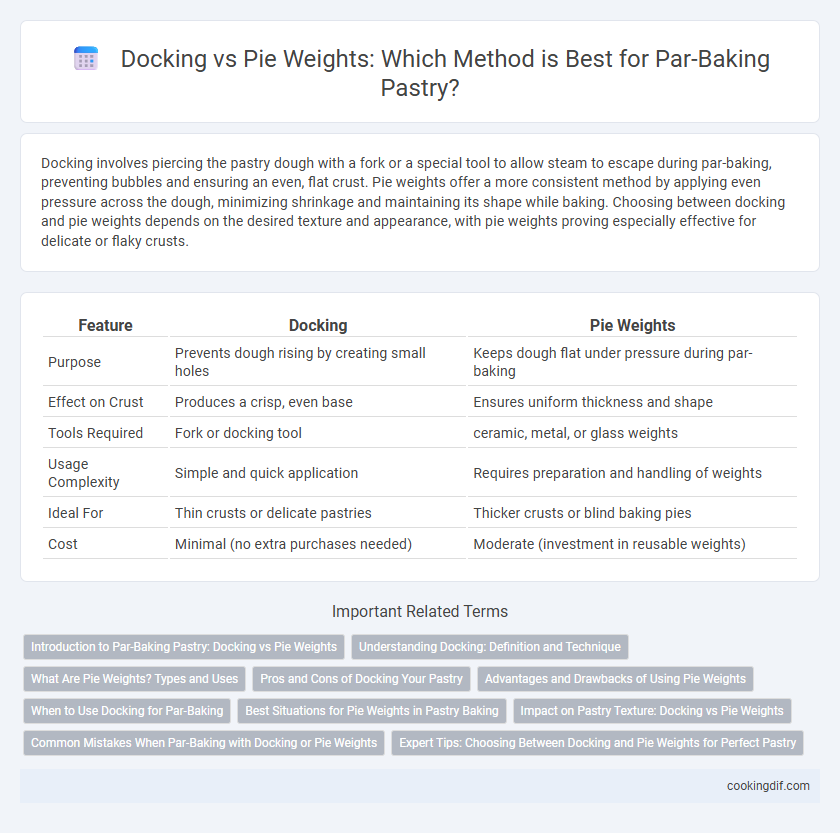Docking involves piercing the pastry dough with a fork or a special tool to allow steam to escape during par-baking, preventing bubbles and ensuring an even, flat crust. Pie weights offer a more consistent method by applying even pressure across the dough, minimizing shrinkage and maintaining its shape while baking. Choosing between docking and pie weights depends on the desired texture and appearance, with pie weights proving especially effective for delicate or flaky crusts.
Table of Comparison
| Feature | Docking | Pie Weights |
|---|---|---|
| Purpose | Prevents dough rising by creating small holes | Keeps dough flat under pressure during par-baking |
| Effect on Crust | Produces a crisp, even base | Ensures uniform thickness and shape |
| Tools Required | Fork or docking tool | ceramic, metal, or glass weights |
| Usage Complexity | Simple and quick application | Requires preparation and handling of weights |
| Ideal For | Thin crusts or delicate pastries | Thicker crusts or blind baking pies |
| Cost | Minimal (no extra purchases needed) | Moderate (investment in reusable weights) |
Introduction to Par-Baking Pastry: Docking vs Pie Weights
Par-baking pastry involves partially baking the crust to ensure a crisp, non-soggy base. Docking creates small holes in the dough to allow steam to escape, preventing air bubbles during baking. Using pie weights, such as ceramic beads or dried beans, applies even pressure to maintain the crust's shape and avoid shrinking or puffing.
Understanding Docking: Definition and Technique
Docking is a technique used in pastry making to pierce small holes into dough before par-baking, allowing steam to escape and preventing bubbles or puffing. Unlike pie weights, which physically weigh down the dough during blind baking, docking relies solely on creating channels for steam release to ensure an even, flat crust. Mastery of docking helps achieve a crisp, evenly baked pastry base without the need for additional tools.
What Are Pie Weights? Types and Uses
Pie weights are small, heat-resistant objects used to prevent pastry crusts from puffing or shrinking during par-baking by weighing down the dough. Common types include ceramic beads, metal balls, and dried beans, each offering uniform weight distribution without adding moisture. Proper use of pie weights ensures a crisp, evenly baked crust essential for custard and fruit pies.
Pros and Cons of Docking Your Pastry
Docking pastry before par-baking prevents air bubbles by allowing steam to escape, ensuring an even, flat crust and reducing the risk of puffing or cracking. However, over-docking can lead to an overly dry or hard texture, while under-docking may not adequately control rising. Unlike pie weights that add consistent pressure, docking offers a quicker, less messy alternative but requires careful technique to avoid compromising pastry quality.
Advantages and Drawbacks of Using Pie Weights
Pie weights evenly distribute pressure on pastry dough during par-baking, preventing puffing and shrinkage for a flat, crisp crust. They allow steam to escape, reducing sogginess compared to docking, which pierces the dough and can create uneven textures. However, pie weights require additional cleanup and storage, making them less convenient than the quick, tool-free method of docking.
When to Use Docking for Par-Baking
Docking is essential for par-baking delicate pastries like tart shells and puff pastry, as it allows steam to escape, preventing puffing and uneven cooking. Use docking when the goal is to maintain a flat, even crust without additional weight, especially in recipes requiring a crisp bottom layer. Pie weights are more suitable when a precise, uniformly flat surface is needed but docking alone is insufficient to control rising.
Best Situations for Pie Weights in Pastry Baking
Pie weights are ideal for blind baking delicate, flaky pie crusts that require even heat distribution without rising or puffing, such as tart shells or quiche bases. They prevent the dough from shrinking and ensure a crisp, evenly baked pastry by applying consistent pressure during par-baking. Using pie weights is particularly beneficial when baking thin or tender crusts that cannot support the weight of docking marks or heavier objects.
Impact on Pastry Texture: Docking vs Pie Weights
Docking creates small holes in the pastry, allowing steam to escape and preventing bubbles, which results in a crispier, more evenly baked crust. Pie weights apply even pressure during par-baking, minimizing shrinkage and maintaining a uniform thickness, contributing to a tender and flaky texture. Using docking alone can lead to a drier crust, while pie weights better preserve moisture and structure for optimal pastry texture.
Common Mistakes When Par-Baking with Docking or Pie Weights
Using docking holes instead of pie weights during par-baking can lead to uneven crusts due to insufficient weight distribution, causing puffed-up or misshapen edges. Relying solely on pie weights without properly docking the dough often traps steam, resulting in soggy spots and compromised texture. A common mistake involves not chilling the dough before par-baking, which increases shrinkage risk regardless of whether docking or pie weights are used.
Expert Tips: Choosing Between Docking and Pie Weights for Perfect Pastry
Docking pastry with a fork creates steam vents that prevent bubbling, ideal for thinner crusts or delicate fillings, while pie weights evenly press the dough to maintain shape and prevent shrinkage during par-baking. Expert bakers recommend docking for crispier, vented bases and pie weights for sturdier, uniform tart shells. Selecting the right technique depends on the pastry type and desired texture, ensuring a flawless pre-baked crust every time.
Docking vs pie weights for par-baking Infographic

 cookingdif.com
cookingdif.com